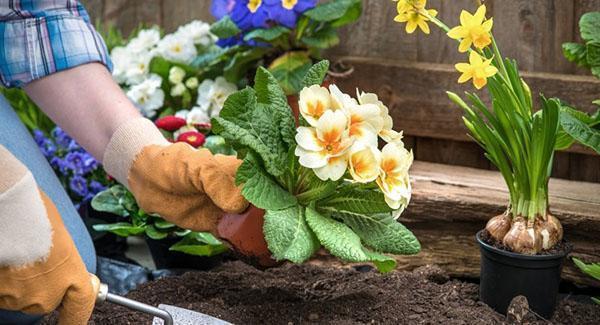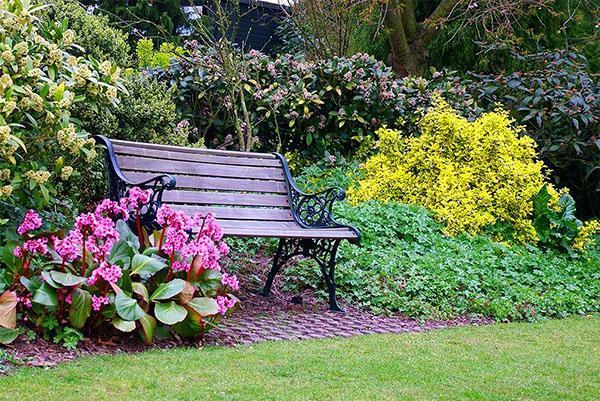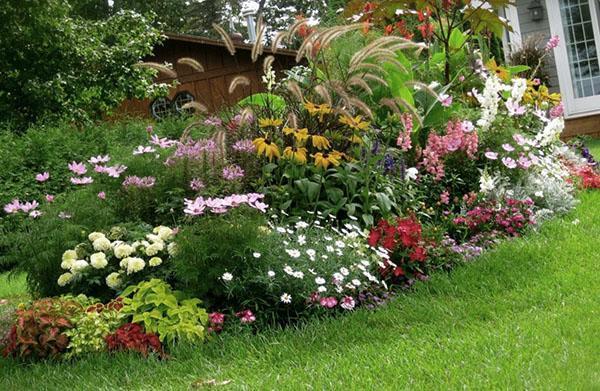Transplanting perennial flowers in flower beds of personal plots
 Perennial ornamental plants are rightfully loved by many owners of home gardens and are actively used by them in landscaping. Since these crops do not need to be sown annually, grow seedlings and transfer them to a permanent place, flowering and decorative deciduous perennials significantly save the time and effort of the grower.
Perennial ornamental plants are rightfully loved by many owners of home gardens and are actively used by them in landscaping. Since these crops do not need to be sown annually, grow seedlings and transfer them to a permanent place, flowering and decorative deciduous perennials significantly save the time and effort of the grower.
They all fall into two large groups:
- wintering ones, that is, those who are not afraid of the winter cold and survive them in their flowerbed or alpine slide;
- not hibernating, requiring annual digging and storage under special conditions until the next growing season.
The second group includes dahlias, gladioli, as well as other species, most of which are bulbous. These cultures need a personal touch. But what about those that do not need annual extraction from the ground and grow well in one place for several years?

- perennials bloom less;
- once lush curtains in the center are thinning;
- plants gradually take over neighboring areas.
In this case, a perennial culture requires transplantation and rejuvenation. How, when and with what frequency is it better to carry out this procedure?
The frequency of transplanting perennial ornamental crops
 Each perennial has its own time when it is time for him to leave his home.
Each perennial has its own time when it is time for him to leave his home.
The shortest interval between transplants in feathery carnations, coreopsis, pyrethrum, some varieties of perennial violets and primrose (primrose long-term planting and care with a photo). The same applies to thyme and oregano, which are often planted in flower beds and in mixborders. Already after 2-3 years, these plants need to be planted. The reason for the rapid loss of decorativeness is that, as they grow old, the roots of plants begin to rise above the ground level, a bald patch is formed in the center of the curtain from the dried up roots and stems of last year. This effect leads to a deterioration in the nutrition of the living parts of the perennial, its development occurs only in the periphery and gradually fades away. Therefore, adult curtains are periodically dug up, carefully divided, and the resulting parts are planted, sprinkling with fertile soil on top.
Loved by many for its luxurious scent and graceful flowers white lilies, other decorative varieties of liliaceae, as well as irises with a superficial root system, are transplanted for a year or two less often.
If this is not done, after 4–5 years, the scaly bulbs of lilies and rhizomes of irises are so deeply buried in the soil that the shoots that form on them are weak and refuse to bloom.
Up to 6-7 years old, hosts, herbaceous peonies, perennial phlox, astilbe and delphiniums, unpretentious bright daylilies and other crops, in which, when excavated, powerful rhizomes are found, which for many years have provided plants with everything necessary for growth and flowering. When transplanting a large specimen, you can and must disassemble it in order to obtain a young planting material.
When is the best time to transplant perennials?
 Transplantation and reproduction by dividing rhizomes is carried out in spring or autumn:
Transplantation and reproduction by dividing rhizomes is carried out in spring or autumn:
- In the first case, the plants are best tolerated by the procedure carried out from the second half of April to the first days of May.
- For the second time, there is an opportunity to transfer perennials to a new place from August to September.
The choice of this or that option depends on the planted culture. Plants blooming in the second half of summer are best transplanted with the onset of warmth, and, conversely, when buds appear in spring, the transplant is postponed until autumn.
Many gardeners prefer to devote the end of summer and the beginning of autumn to the care of perennials for the simplest and most understandable reason. During this period, they have more free time for such a pleasant, but rather troublesome job.
However, experienced florists associate serious risks with autumn transplantation. If you are a little late, then perennials that have not been rooted again before the cold weather in winter may suffer or even die. Therefore, the procedure is always consistent with the long-term weather forecast, taking into account the frost resistance of crops and the climatic characteristics of the region. It is better if during the transplant there will be dry weather with an air temperature of at least 12-15 degrees.
Features of transplanting plants with a different bark system
 Perennial plants with a shallow root system or with fibrous roots that do not go deep underground are easy to dig up and transplant. Even the loss of some part in this case will not harm, because this is how the multiplication of culture takes place. The above fully applies to violets, pyrethrum and sycamore, rudbeckia and echinacea, numerous species of ornamental and spicy plants belonging to the family of lacunae, for example, monarda, oregano, lofant, lemon balm and mint.
Perennial plants with a shallow root system or with fibrous roots that do not go deep underground are easy to dig up and transplant. Even the loss of some part in this case will not harm, because this is how the multiplication of culture takes place. The above fully applies to violets, pyrethrum and sycamore, rudbeckia and echinacea, numerous species of ornamental and spicy plants belonging to the family of lacunae, for example, monarda, oregano, lofant, lemon balm and mint.
It is best to transplant such plants in the fall, when they are clearly visible, and the dried aerial part can be cut off without regret, damaged or rotten rhizomes removed. Large clumps are divided so that the resulting parts take root after planting and give new shoots.
Do the same with irises, peonies, lilies of the valley, and badan. The roots of these plants are outwardly different in appearance, but in the presence of potential points of growth, the cuttings will soon sprout independently.
 The most difficult is the transplantation of perennial crops with a taproot system. An example is the Persian poppies and dycenters, lupins, delphiniums and aquilegia, which are extremely painful to damage to the roots, but also do not grow as much as their fellows with fibrous rhizomes. Therefore, it is better not to disturb such crops without the need, but only to carefully separate the daughter plants that form at the base of the outlet.
The most difficult is the transplantation of perennial crops with a taproot system. An example is the Persian poppies and dycenters, lupins, delphiniums and aquilegia, which are extremely painful to damage to the roots, but also do not grow as much as their fellows with fibrous rhizomes. Therefore, it is better not to disturb such crops without the need, but only to carefully separate the daughter plants that form at the base of the outlet.